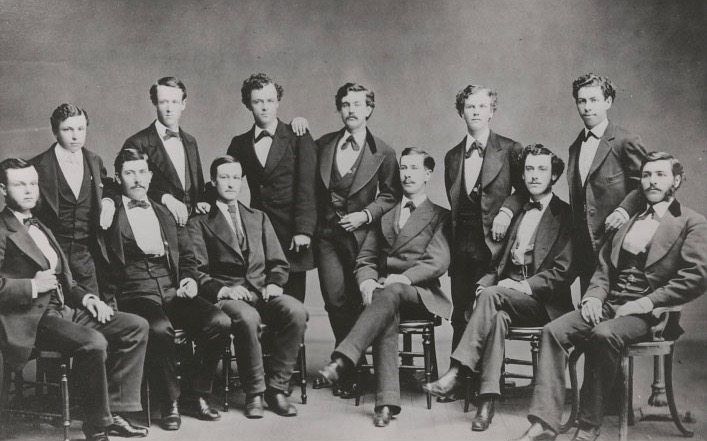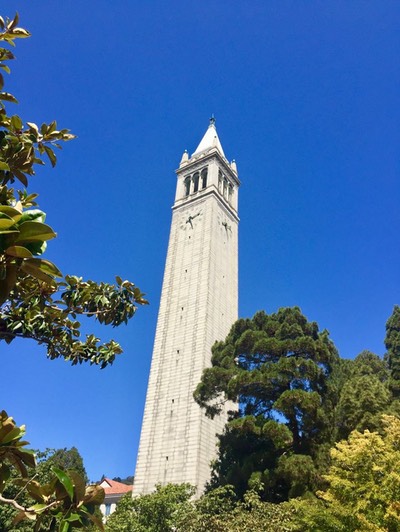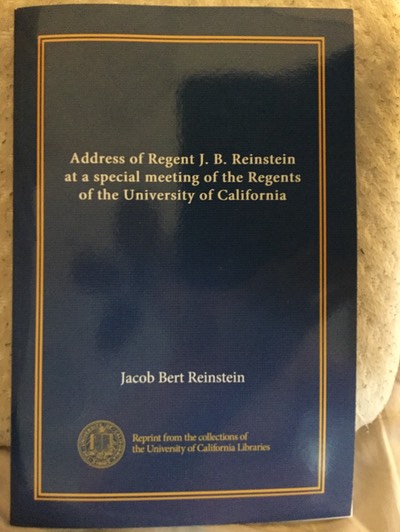
The “Twelve Apostles”, the first graduating class of of UC Berkeley in 1873.
Jacob Bert Reinstein standing far left in photo.
In the 1970s I attended UC Berkeley. Little did I know I had an illustrious relative, Jacob Bert Reinstein (1854-1911), who was in the very first graduating class of UC Berkeley. The “Twelve Apostles” as they were dubbed graduated in 1873, exactly a century before I attended Cal. He is in the photo above, standing on the far left of the group.
Not only was my great-granduncle, J.B. Reinstein, one of the very first Berkeley Bears, but he was also appointed UC Regent in the 1890’s. As Regent, he collaborated with philanthropist Phoebe Apperson Hearst to expand UC Berkeley, helping to make it a world class university.
Jacob Bert Reinstein was born in 1854 in Visalia, in California’s Central Valley. His parents, Oscar and Hannah Reinstein, were Jewish immigrants from Posen Province in Prussia. They arrived in California during the Gold Rush, selling goods and services to gold miners. Jacob was the first born of the Reinstein’s five children. His four siblings included: Adeline (1856 -1923), Mary (1858-1945), Lena (1861-1924) our great grandmother, and Augusta (1864-1914).
Cal's "Twelve Apostles"
During the 1860s the Reinsteins moved to San Francisco. Jacob entered the brand-new University of California in 1869. The first instruction was held in Oakland with only ten faculty members and forty students. While he attended Cal, J.B. was a member of the Phi Delta Theta Chapter House. In 1873 Cal completed two buildings on the current Berkeley campus: The North Hall and the South Hall. The North Hall is the current site of the Bancroft Library.
J.B. Reinstein and eleven classmates graduated in 1873, the very first class of the new university. The dozen was called the "Twelve Apostles". They were a talented group, who went on to be movers and shakers in late nineteenth century California. The Brief History of the University of California lists their accomplishments in its photo caption:
The Twelve Apostles, graduates of the Class of 1873, would become distinguished citizens and public servants. Left to right, standing, are J. B. Reinstein, later a Regent; Frank Otis, Mayor of Alameda; James H. Budd, Congressional Representative and Governor of California; Thomas P. Woodward, engineer and educator; Clarence Wetmore, businessman; and Nathan Newmark, attorney. Seated are George C. Edwards, professor of mathematics; L. L. Hawkins, bank president; Franklin Rhoda, clergyman; Ebenezer Scott, businessman; George J. Ainsworth, Regent; and John M. Bolton, rancher.
Lawyer and UC Regent
After Cal, J.B. Reinstein became a lawyer. Our uncle, Milt Silverman, wrote that J.B. “studied law - coached by his father. Passed the bar examination, became personal attorney for Phoebe Apperson Hearst, mother of William Randolph Hearst.” Phoebe Hearst and our great-great-uncle would work closely together in the 1890s to plan the expansion of UC Berkeley.
Jacob’s law firm hired another Cal graduate Milton Sidney Eisner. It appears J.B. played matchmaker, introducing Milton to his younger sister, Lena. It was a successful match; our great grandparents wed in 1884.
In 1895 J.B. was appointed Regent of the University of California by Democratic Governor James Budd. J.B. and Budd had been classmates at Cal, both part of the first graduating class in 1873. Budd had gone on to serve in the US House of Representatives and was elected the 19th Governor of California in 1895. On December 28th, 1895 The Alumni Association of University of California honored J. B. Reinstein, one of their own, with a dinner at the swanky Palace Hotel in San Francisco.
A Plan to Expand UC Berkeley
In 1896, J.B. Reinstein proposed to the UC Board of Regents that they expand and improve the campus, “befitting the best and noblest purposes of the state.” As the story goes, Reinstein approached Cal drawing instructor Bernard Maybeck about designing large scale improvements to the University. Maybeck proposed an architectural competition to solicit plans. The real breakthrough came when Reinstein pitched the idea to philanthropist Phoebe Apperson Hearst, who agreed to use part of her husband’s mining fortune to bankroll the competition.
In mid-October J.B. Reinstein, Professor William Carey Jones, and Phoebe Apperson Hearst met to finalize the concept. At the Bancroft Library, I found and read Phoebe Apperson Hearst’s letter to J.B. Reinstein. On October 22nd, 1896 Hearst sent a letter from her Palace Hotel suite addressed to Regent J.B. Reinstein. She wrote:
Dear Sir,
Referring to the conversation which I had last week with yourself and Professor Wm Carey Jones, I desire to say that I am deeply impressed with the proposition now before the Board of Regents to determine upon a comprehensive and permanent plan for the buildings and grounds of the University of California, on the site at Berkeley, and heartily approve of the idea.
I feel now so imbued with the importance to the University and to the State of having such a plan, that I should be glad to aid in its complete and speedy realization. I may also say that I am the more anxious for this as I have in contemplation the erection on the University grounds of two buildings, one of them to be a memorial which shall testify to Mr. Hearst's love for and interest in this State.
I would therefore suggest that I be permitted to contribute the funds necessary to obtain, by international competition, plans for the fitting architectural improvement of the University grounds at Berkeley, and I desire to say that the success of this enterprise shall not be hampered in any way by a money consideration.
I have only one wish in this matter--that the plans adopted should be worthy of the great University whose material home they are to provide for, that they should harmonize with, and even enhance, the beauty of the site whereon this home is to be built, and that they should redound to the glory of the State whose culture and civilization are to be nursed and developed at its University.
As the full execution of these plans will probably require a long period of time, and one of constant and assiduous attention, I should like to suggest that this trust be reposed in a special committee which shall represent the several interests involved. I would name as such trustees, His Excellency James H. Budd, representing the State; Regent J. B. Reinstein, representing the Board of Regents; and Professor William Carey Jones, representing the University.”
Reinstein wasted no time in replying to Hearst’s letter. He sealed the deal the same day, writing:
Dear Madam,
I am in receipt of your letter of today expressing your earnest wish for an International architectural competition for a permanent and grand plan for buildings and grounds of the University of California at Berkeley, and also your splendid gift to further the obtainment of such a plan.
Perhaps nothing at this time could be more opportune or important for the state University than the wise gift and the gracious influence of its donor, through which we may hope soon to obtain a plan which shall contemplate upon the superb site of this University, buildings in every way worthy of a great State and its highest institution of learning.
Whatever may be considered the important needs and the factors of success in this University, it is certain that they all will be subsumed immeasurably by buildings which shall embody the power and dignity of a sovereign State, at the same time that they shall exalt education by the inspiration of glorious architecture, making patriotism and a lofty regard for the State as certain as a result of a course as this University as love for what is beautiful and true.
Your thought and kindness foreshadow such a plan as will accomplish this double purpose and in addition, will spur the pride and interest of State and individuals to steadily realize that plan, in useful beautiful and harmonious structures.
I shall take the earliest opportunity to bring your letter to the attention of the Board of Regents, and with your permission, will accept with pleasure my share of the great trust conferred. In the meantime, permit me to express to you on behalf of all who cherish the welfare of the University of California a sense of deep and lasting obligation.
Yours very sincerely,
JB Reinstein
JB Travels East and to Europe
Along with Reinstein, Governor Budd endorsed the plan with his letter. The Regents voted unanimously to support what was to be called, the Phoebe A. Hearst Architectural Plan. By winter of 1896, J.B. Reinstein and Bernard Maybeck were in New York and other Eastern cities. They were consulting architects and visiting the Federation of Fine Arts in New York to get ideas.
In the May of 1897, J.B. Reinstein joined Mr. Maybeck in Europe. When they returned from Europe, Mr. Reinstein gave an interview, describing his activities in Europe.
We have been to London, Edinburgh, Manchester, and to the towns and cities of Great Britain containing the principal monuments of architecture, as well as to Paris, Brussels, Hamburg, Denmark, Berlin, Leipzig, Prague, Strasburg, Heidelberg, Dresden, Vienna, Budapest, Milan, Verona, Venice, Rome, Florence, Geneva, and other cities, interviewing leading architects, artists and landscape gardeners, and enlisting their interest and aid. The greatest and most renowned architects, artists and landscape gardeners, prominent all the world over for the work they have done in connection with educational institutions, have not only given us most cheerfully and most freely of their time and attention, of suggestion and counsel, but have received the proposition with unbounded enthusiasm. They have entered into its accomplishment with whole-souled enthusiasm and without any hint or thought or pecuniary recompense. Everywhere we have been told that the plan affords the greatest opportunity that has ever been offered in the history of architecture.
J.B. Reinstein was nothing if not enthusiastic about the project. In 1897 a prospectus was created for the competition. According to Calisphere, "Eight thousand copies of this “Programme for an International Competition for the Phœbe A. Hearst Architectural Plan of the University of California,” were issued, four thousand in English, two thousand in French, and two thousand in German.”
The 1898-1899 competition for Phoebe Apperson Hearst’s $10,000 prize money produced no fewer than 105 entries. The deadline for submissions was August 1, 1899. Eleven architects made the finals. Their plans were housed at San Francisco’s Ferry Building to be judged by an distinguished international panel. Rounding out the five-judge panel, and representing the University, was J.B. Reinstein.
Cal Picks the Architectural Expansion Plan
The San Francisco Call reported on August 31, 1899, "Famous Architects From Abroad Come to Judge University Plans.” The architects and J.B., visited the Cal Berkeley campus to see the site, escorted by Phoebe Hearst. They were treated to a concert at San Francisco’s City Hall and met Mayor Phelan.
The following day the commission inspected the architectural entries at the Ferry Building and enjoyed a banquet at the Palace Hotel. The third day of their visit they toured the Bay by boat and spent a night on Mount Tam, my old stomping grounds. Later in the week the architects were entertained by Phoebe Hearst at her home, and attended a banquet at the Cliff House. On the final day of their visit, the judges returned to the Cal Campus, where they were greeted by students and faculty.
The Commission awarded the $10,000 prize to French architect Emile Bernard. However, Bernard chose not to come to the US to implement his plan for the expansion of Cal. Instead, Bernard’s vision was carried out by another architect in the competition, John Galen Howard.
In the1890’s, twenty years after J.B. graduated Cal, the population of Berkeley was just 5,000 people. In those same two decades, the University had only added three wooden buildings to its existing two campus halls. After the Phoebe Apperson Hearst Architectural Competition, Howard oversaw the construction of eighteen buildings in the Beaux Arts style. They included some of the most famous structures on the Cal campus including: The Campanile, Doe Memorial Library, California, Durant, and Wheeler Halls, The Hearst Mining Building and the Hearst Theater, and Sather Gate. The partnership of Hearst and Reinstein led to a rapid expansion of Cal’s campus after the turn of the century.
J.B. Reinstein’s Address to the UC Regents
J.B. Reinstein spelled out his vision for the University of California in a speech he gave to the Regents in 1898. I was alerted to J.B.’s presentation, Address of Regent J.B. Reinstein at a special meeting of the Regents of the University of California, by my cousin Don Brunsten. He read the short book, sending me his excellent summary. Don wrote,
The first thing that comes through is J.B.’s love of his home state, California… He emphasizes the importance of California and the Pacific Coast to the future of the United States, “in peace and war.” In so doing, he rather eerily anticipates events that would unfold about 43 years later.
The second, clear feeling from the address is J.B.’s love of the University. In 1898, he is keen to compare Cal with elite, established institutions like Harvard, Yale, Columbia, and Cornell. As a role model, he seems particularly interested in the then-new and upstart “Chicago University,” aka University of Chicago. At various points, J.B. slyly mentions to the Regents how “one of your number” recently toured all these noble academies and was able to hobnob with their presidents and top educators. J.B. can take some credit for pioneering the personal junket on the University’s behalf.
In looking at these other colleges, and getting into the nitty gritty about their enrollments, expenditures, faculties, and endowments, J.B. studiously ignores another promising upstart. This upstart was established at the same time as Chicago, but in a rather more nearby locale called Palo Alto. The omission makes a good deal of sense when the next part of the address is considered.
As a regent, J.B. became the driving force in a very ambitious plan to build out and enlarge the Berkeley campus, all under a world class architectural scheme... Accordingly, J.B. devotes a great deal of the address to the Regents to promoting the “royal generosity” of Phoebe Hearst and the Hearst Architectural Plan for the University...
J.B. also gives a brief shout out to Mr. Levi Strauss, who had underwritten scholarships at the University. Mr. Strauss’s descendants by marriage, and the heirs to Levi Strauss & Co., the Haas Family, didn’t really need the scholarships for themselves. But Walter Haas, Jr. had a good friend and roommate at Bowles Hall, named Stan Brunsten, who probably did.
In the end, J.B.’s address to the Regents is an urgent call for funding, both private and public, for the growth and enhancement of the University. At least some of his arguments seem persuasive. And it’s fun to see the language a Reinstein used in 1898 to make a point. Looking back, J.B. can be seen as one of the key development officers in Cal’s history.
First of the "Twelve Apostles"
Said another way, J. B. Reinstein was first among the Twelve Apostles for his vision to build Cal into one of the world’s top public universities. The San Francisco Call 1911 obituary, "J. B. Reinstein Called by Death," lauded his accomplishments:
He was an efficient worker for the university and rendered excellent service as a member of the committees on grounds and the medical department. He planned and took a prominent part in the architectural competition which Mrs. Phoebe Hearst inaugurated to secure comprehensive plans for the rebuilding of the university. The competition was successful in every way, and the buildings now being erected on the university campus are in accord with the general plans of M. Bernard, who was awarded the prize in the competition. Regent Reinstein inaugurated the student volunteer movement which led to the improvement of the grounds of the university 11 years ago. Reinstein was elected a graduate member of the Golden Bear honor.
We also learn from his obituary that our great-granduncle was “a staunch democrat…. and a skillful whist player.” Not mentioned, but worthy of our praise, is that J.B. Reinstein was a charter member of the Sierra Club in 1892. Don shared that J.B. was recognized for this early support of John Muir and the Sierra Club by the naming of Reinstein Peak in the Kings Canyon National Park.
Playing the "Reinstein Card"
Several generations of J.B. Reinstein’s relatives attended Cal, including my daughter Tamiko. I was a student at UC Berkeley exactly a century after my great-great-uncle graduated from the University. I don’t think most of us knew when we studied at Doe Library, attended lectures at Wheeler Hall, or went to concerts at Hearst Theater, that we had our predecessor J. B. to thank in part.
Most of us had no idea our ancestor played such a prominent role in the growth of Cal. My cousin Bill Brunsten had the best line at our revelation. He quipped, “If I had known about the family history, maybe we could have played the “Reinstein card” with the admissions department.”
Of course, I’d never propose my grandchildren play the "Reinstein card” should they want to go to Cal. Although on second thought, it couldn’t hurt to mention J.B. in their applications and their family connection to our illustrious relative.
DF- First Draft 09/ 2019



